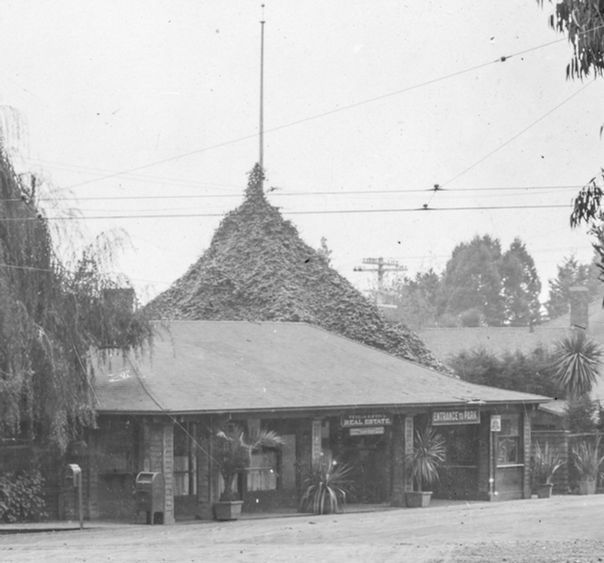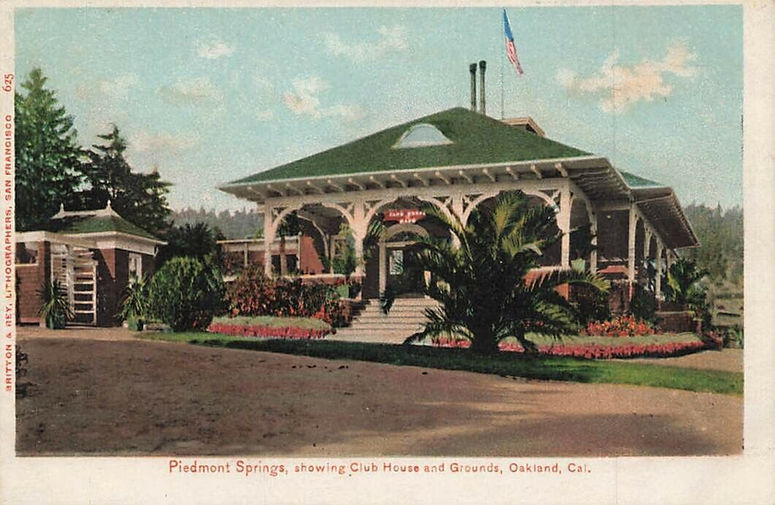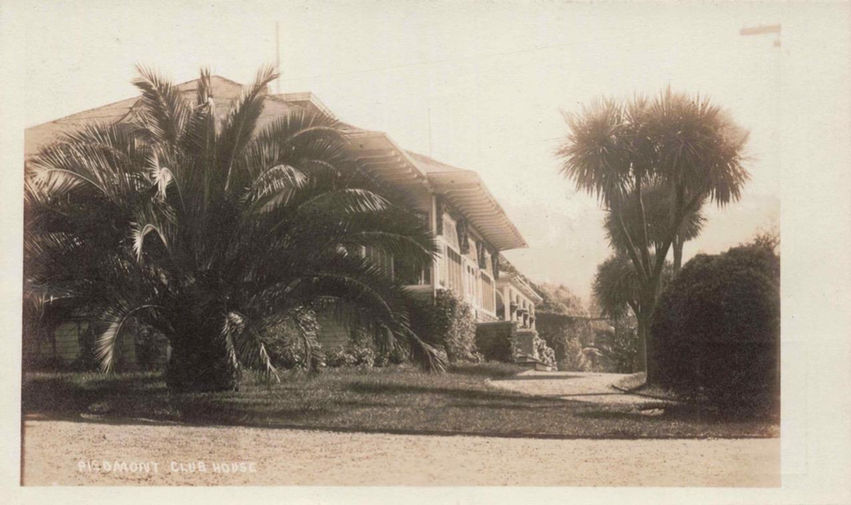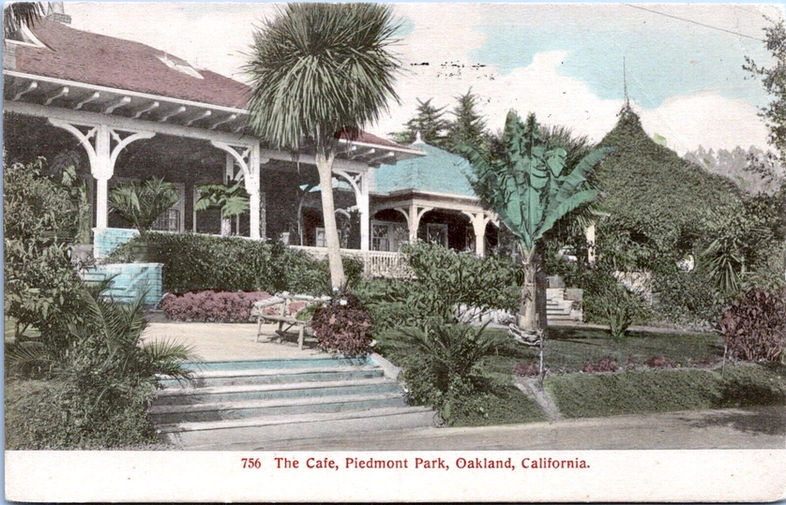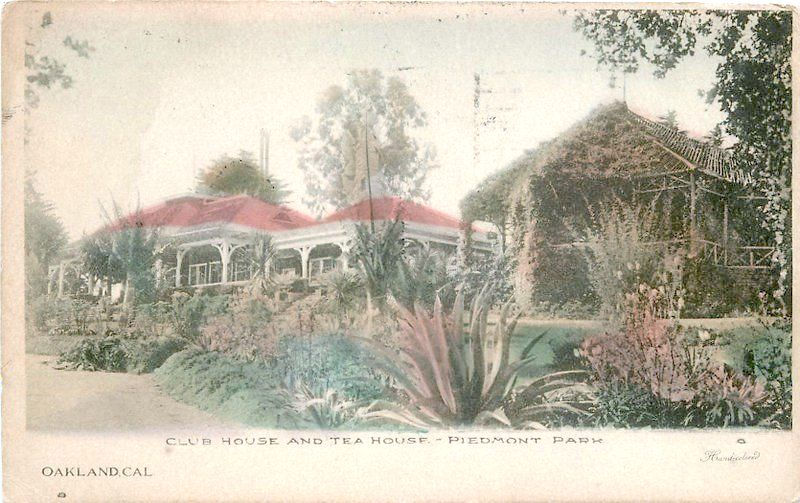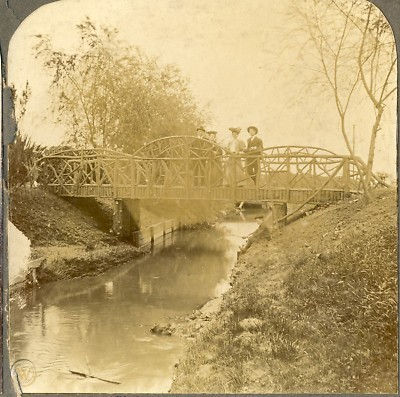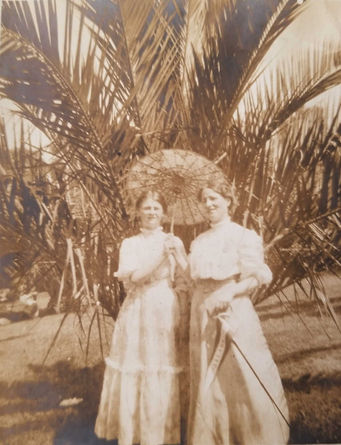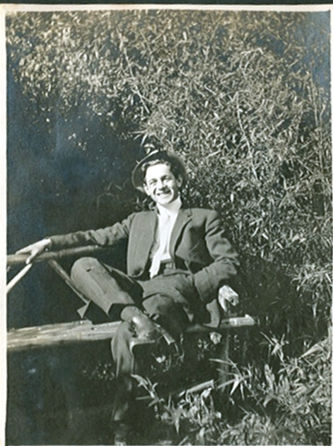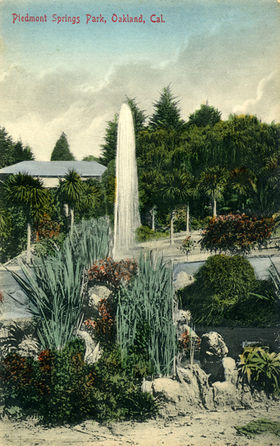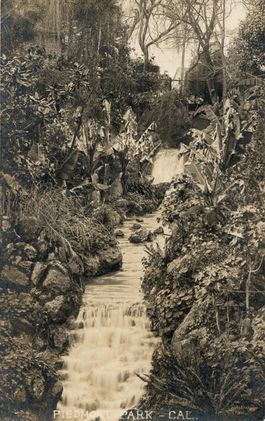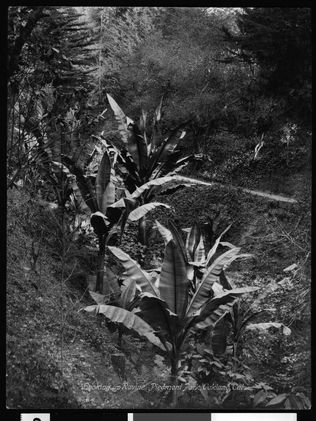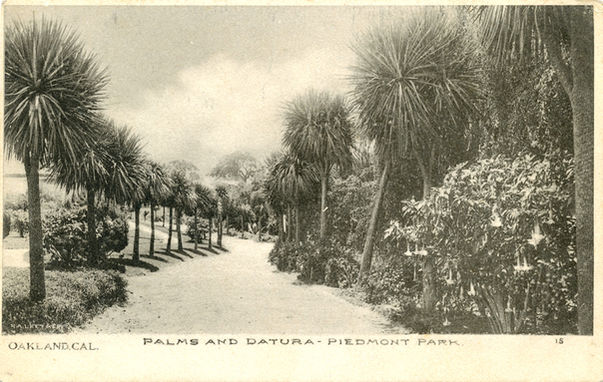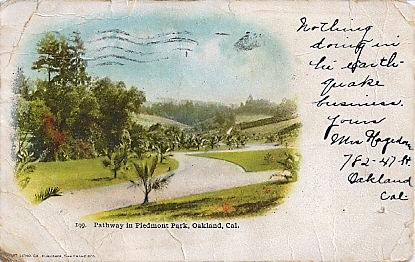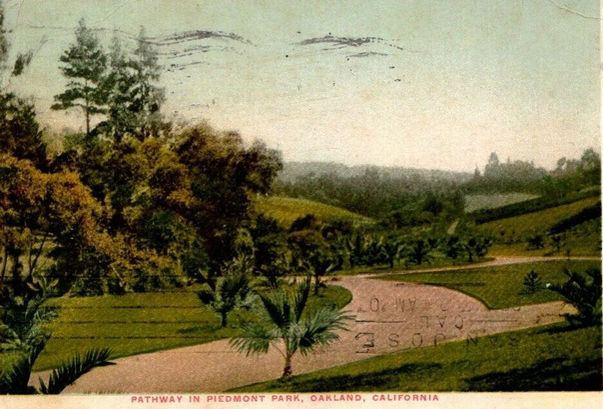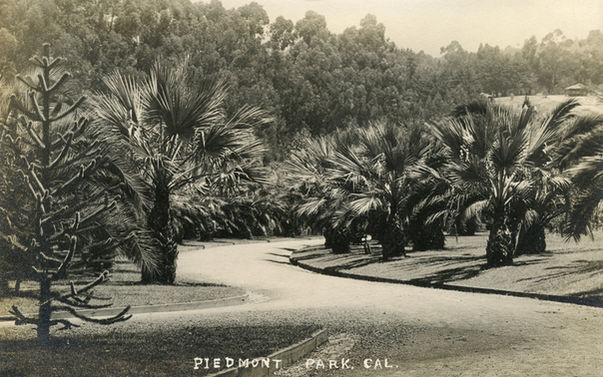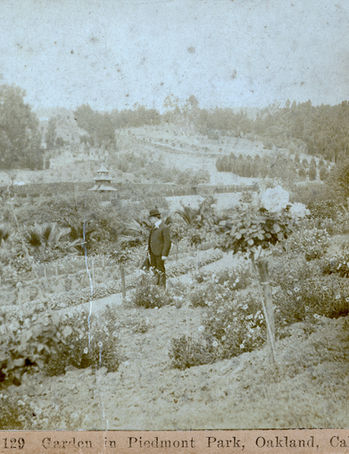Piedmont Park (after 1898)

The San Francisco Call - Mon - Mar. 28, 1898
The Piedmont Springs Clubhouse was
built at the top of the park across from today’s Wells Fargo bank.
1898 - The New Park:
Oakland Tribune - Thu - Mar. 24, 1898:
The Piedmont Development Company, an adjunctly of the Realty Syndicate (including Frank C Havens), intends to build a club house on the site of the old Piedmont Springs Hotel, which was burned down. It will be a rusting building finished in a picturesque fashion. Refreshments will be served, and a small admission fee will be charged for entrance to the grounds.
Oakland Tribune - Sat - May 7, 1898
Piedmont’s Terrestrial Paradise
Years ago there was a hotel at Piedmont. Adjacent to the hostelry was a series of springs of mineral water, comprising Sulphur of varying degrees of strength, iron and magnesia. These springs bubbled in muddy pools at the bottom of deep ravines. To reach them one had to risk their neck.
On night, the hotel went down in ashes, and the springs at the same time, began to live in the memory of those only who love the past.
With the new Oakland there has been a revival of the pleasures of the past generation, and a renewal of the media which once figured in those in diversions, and, incidentally, contributed to the well-being of no small portion of the community.
At Piedmont, on an eminence from which, through a vista of romantic beauty may be viewed the distant main, the original hotel has been replaces by a chaste, modern and artistic club house, while, within easy reach of the same acclivity, through embowered in a greenwood of extraordinary variety and attractiveness, the same vigor-inspiring, health-giving springs are again brought within reach of the people.
In course of time another hotel will proudly rear its pediments beneath the foliage, and there will then be little need for people to go from their homes to regain the physical and mental qualities which they may have lost.
S. F. News Letter - August 27, 1898:
One of the most brilliant garden parties of the summer was given last Saturday afternoon and evening at Piedmont Springs, where all the leaders of Oakland society united with the Young Ladies' Relief Society of Oakland in making it a pronounced success. The decorations as well as the electric lights were in red, white and blue, and the tea, lemonade and candy booths, presided over by some of Oakland's fairest daughters, did a rushing business. During the afternoon there was a drill by members of the Tennessee Regiment, the band of the Iowas discoursing excellent music; and in the evening there was a camp fire, with appropriate songs and choruses by some of the Eighth Regiment's men.

Alameda Daily Argus -
Wed - May 11, 1898
Entering the Park:
"Piedmont Springs" by Carlotta Sessions
Overland Monthly 1901-12: Vol 38 Iss 6, pg 511:
Comparatively few know this idyllic spot is located, and still it nestles at the foot of a wide range of hills in one of California’s most populous districts. “Oakland has no park,” said a tourist recently. No park! Just take the Piedmont car at 14th street, and ride to the end of the route! Out from the busy city, past lovely rural houses, up hill and down, by swift transit, until the car halts, at the end of the line, before a lonely depot, at the foot of a soft-hued mountain, no sign of life or habitation near.
Puzzled eyes finally see a sign, “To Piedmont Springs.” “How far?” “Only a block,” the accommodating conductor replies.
The pretty, tree-lined road, slightly elevated at first, in its descent presents a view of delightful possibilities. A small unique building and a turn-stile labeled “Piedmont Post Office,” guards the entrance to the park. This is a very recent innovation. Beyond may be caught glimpses of broad paths, bright-hued flowers, a charming villa (the “Club-house”) and trees and shrubs innumerable.
The entrance pittance paid, the swinging gates unfold a Paradise! In the foreground a substantial setting to the picture, is the Club-House, with slanting roof, wide verandahs, tables and chairs arranged cozily; a type of civilization breaking in upon Nature.
Various narrow paths lead off, mysteriously, down into the ravine. Following one of these the world is left outside, and a perfect fairy-land of wooded beauty appears. Down, down, the little path winds besides a big, flowery canyon, beneath overhanging rocks and trees. The saucy sun peeps through the foliage upon the lilies and palms which rear their heads in the lavish insolence of Nature upon either bank of the canyon. Rustic bridges span the deep crevasse, and fine old trees, blue gums and others, rise upon either side as though to shield its beauties from the outside world.
One mighty oak is noticeable upon the left bank of the canyon, about midway to the Springs, whose youth is over, but whose sturdy trunk is covered with names and initials, and whose strong, outspreading arms support a small platform containing rustic seats for the visitor. The effect is picturesque, reminding us, too, that the world has been here and left tokens of its presence. Further on we are again reminded of this fact, for there are large tables and benches evidently designed for picnic parties.

1911 Sanborn Map

Oakland Tribune - Sat - Dec. 27, 1902
Candy at the entrance:
Oakland Tribune - Tue - Apr. 9, 1912
George Meros has gone to the Meritt hospital to undergo an operation
"George,'' as he is best known in Piedmont, has kept the candy stand at the entrance of Piedmont Park for a number of years, and during that time has been the particular friend of the children, and is well known to all the horses and dogs thereabout, who never beg for a sweet morsel in vain.

1907 Wickam Real Estate Map
Clubhouse
1898 - Club house:
The Overland Monthly 1901:
The original hotel was burned down, and the new modern Club-House is not only frequented by the public during the day, but is rented for private affairs, dinners, etc., In the evening. In the early days that portion of Piedmont was known as Blair Park, was thronged by thousands on Sunday, when open-air concerts and balloon ascensions were given with a view to attracting the public. The present owners desire to keep the Park artistic and refined, and intend to make it the most beautiful pleasure-ground in California.

Oakland Tribune - Tue - Nov. 27, 1900
Oakland Tribune - Sat – May 7, 1898:
THE CLUB HOUSE
Near the main entrance is the club house, where all kinds of edibles and non-intoxicating liquors may be procured. This place is well appointed, having a fine kitchen, a pantry, a large dining-room, with capacious verandas. Tables will be laid in the dining-room and verandas and, by means of an electric bell at each table, patrons may, in an instant, demand immediate attention. This place will be in charge of the Hallahans, the well-known caterers, and this fact is a guarantee that it will be one of the great attractions of the place.
... This evening the park will be open for the first time. The price of admission will be ten cents. The proceeds will be given to the Ladies' Relief Society.
At night the place will be illuminated by electricity.
... The park will not be open Sunday nights.
There will be no charge for admission of carriages to the park, the occupants, alone, paying the small fee above required. Children will be charged five cents.
Menu:
A clubhouse diner had the choice of oysters on the half shell, striped bass with Hollandaise sauce, roasted chicken, French fried potatoes, cakes, fresh fruit and ice cream.
Jack London & the Ruskin Club's Socialist meetings:
Elise Whitaker Martinez's Oral History:
I think it was about 1897 to 1901, when my father left the party. Encouraged by Ina Coolbrith, a literary Oakland librarian, some members of the socialist group organized the Ruskin Club.
Humanities and Social Science Online:
London was a charter member of the Ruskin Club (a group of Oakland intellectuals, mostly socialists, more Fabian than Marxian), founded by Frederick Bamford in 1898, and soon began speaking at various socialist gatherings in the Bay Area.
The Overland Monthly 1901:
The original hotel was burned down, and the new modern Club-House is not only frequented by the public during the day, but is rented for private affairs, dinners, etc., In the evening. In the early days that portion of Piedmont was known as Blair Park, was thronged by thousands on Sunday, when open-air concerts and balloon ascensions were given with a view to attracting the public. The present owners desire to keep the Park artistic and refined, and intend to make it the most beautiful pleasure-ground in California.


Berkeley Daily Gazette - Fri - Sep. 6, 1907
Oakland Tribune - Sun - Mar. 10, 1907
Grotto and Springs
"Piedmont Springs" by Carlotta Sessions
Overland Monthly 1901-12: Vol 38 Iss 6, pg 512:
But the most interesting structure in this lovely dell is the “Grotto.” What appears as a tremendous boulder has been built deep in the hills, and there, in the twilight of concealed electricity ferns cluster around springs of sulphur and magnesia water, while, within a tiny aquarium, inserted in the rocky wall, fish dart about, flashing light from their golden fins. It all seems so natural that it is hard to realize that the artistic ingenuity of man had planned and executed such a lovely picture. Towards the northern entrance several thickly verdured trees shroud the canyon in temporary gloom, but beyond lies a wide area of broad open sunshine. This is the entrance on the north, and has been reserved for gardening purposes, and several hundred rose bushes are continually in bloom, besides quantities of palms and exotics, which have been planted there. Piedmont Springs is rapidly being extended, and soon all its sixty acres will be under full cultivation.
Oakland Tribune - Sat – May 7, 1898:
FALLING WATERS.
From an altitude of several hundred feet, high up the mountain side, a stream of crystalline water, emerging from the activity beyond, falls into the canyon. For years and years its tide had flowed unnoticed. It sang alone in the stillness and the dark. It made passing acquaintances with the pebbles. It rose over jagged rocks, swirled around sharp pyramidal obstructions, dropped with a musical cadence into basins which it had itself carved out of the everlasting rock, and then hurried away on its eventual destination, the deep sounding sea.
CONTROLLING THE STREAM.
Today, a massive reservoir, with a compacity of 20,000 gallons, marks the initiative of the stream as it bursts from the hill-side. There is a flood-gate at one extremity of the reservoir, and through this, at will, the liquid from the mountain may be allowed to flow. When first freed from its imprisonment, the water drops with a resonance into a basin with a floor of hard rock, laid less regularly that it would have been by nature, and yet not with that degree of mechanical skill to purposely show that it is the work of human hands. After a short glide there is a dam, though the open lips of which, the limpid water roll, going over the edge in a bright, thin sheet, with the sheen of silver reflecting the sun light.
. . .A view of both these scenes may be had from bridges thrown at angles over the stream so as to enable a most perfect prospect to be enjoyed of every salient feature. These bridges are of rustic design and construction and the material employed in their erection has been taken from the surrounding grounds. …It was from this well that, in other days, the water supply of the old Piedmont hotel was obtained.
THE GROTTO.
These (mineral springs) have now been housed in, sealed up so that they may not be contaminated, and they are now all made tributary to the grotto, which is situated near the southern extremity of the grounds. This grotto is of rock taken out of the stream bed, circular in shape, with a vestibule and an inner court, surmounted by a dome fashioned after that of St. Paul’s Cathedral from the apex of which are dependent a cluster of red incandescent lights. There are apertures in the walls though which the light of day will also be admitted. In the center of the floor is an urn through which each of the mineral waters before referred to come, at the will of the visitor through a faucet, and a basin which carried off the superfluous material. The ceiling of this grotto is decorated in heavy rustle work, the arches of which are symmetrically trained and glisten with crystalline formations of borax and other brilliant illuminants.


Oakland, hub of the West by Weber, David (David O.); Menzel, Peter, 1948- Publication date 1981, p64:
The waters at the hotel at Mineral Springs in the lush Piedmont Park foothills were said to possess curative qualities.
The Grotto and Springs Today:
In the 1950s, residents complained of the sulphur fumes, and the city capped the spring.
Walk it today via oaklandgeology.com
Bushy Dell Creek runs through Piedmont Park and joins Pleasant Valley Creek at Grand Avenue. Wildwood Creek runs from approximately Crocker Park to Lakeshore. Wildwood Creek is not in Piedmont Park. Its two branches run down the valleys between Wildwood Avenue and Wildwood Gardens (thence across Harvard Road), and between Wildwood Gardens and Woodland Way.
So you were listening to the rushing waters of Wildwood Creek as it crosses Harvard Road. My authority is the creek/watershed map published by the Oakland Museum, but Google Maps’ terrain view is helpful too. The Oakland Museum map shows the creek as being open as far as Harvard, where it enters a culvert between 1139 and 1143 Harvard Road.
The Park


The Canyon, Palm Walk and Palm Drive:
The Historical Marker Database
Even in 1890, the Piedmont Springs canyon was never steep enough to create a true waterfall. Never one to let nature determine aesthetics, Frank Havens designed his own artificial falls which he named The Cascade. To complete his Victorian vision of a lush tropical paradise, he lined the pathway near the falls with banana palms, canna lilies, cordylines and other plants from the tropics.
Piedmont Post, June 16, 2021:
The main entrance to the park was at the current bus stop across from the Wells Fargo bank, but visitors could also access the park by a path from Grand Avenue on what is now Palm Drive.
...The majestic palm trees are over 125 years old, and are the last remaining trees that lined the path from Grand Avenue to the lower entrance of Piedmont Park and the Maze. The palms are in the front yards of the homes, not on city property. Sherry Jacobs, who lives nearby, told the group that some trees have been removed over the last few years. It had been a beautiful morning with lots of Piedmont history and good conversations with friends.
Palm Walk
The Maze
1904 - The Maze:
In 1904 Havens built “The Maze.” Gardeners planted a large circular hedge maze in the natural bowl where Witter Field stands today. This privet maze challenged all who entered to reach the bright red pagoda at the center. Ladders strategically placed throughout the Maze allowed those feeling hopelessly lost to climb a ladder to the top of the hedge and get their bearings. And true to the nature and design of mazes, the Maze in Piedmont was a double challenge; the return trip out of the Maze was just as challenging as that to the center. By this time, there was a lower entrance to Piedmont Park. Havens developed a lane from Grand Avenue to the Maze and on to the park paths. He lined it with palm trees, some of which still survive on what is now Palm Drive.
The Historical Marker Database
One of the first improvements made by Frank Havens to Piedmont Springs Park was the construction of a living hedge maze modeled on those like Hampton Court in England. An article in the Oakland Herald in December 1904 shows a winding drive leading to a natural bowl and the new maze. Missing from the picture is a red roofed pagoda and fields of roses that would be added later.
The maze was demolished when a new School Board purchased part of the park land in 1920 for its new high school and future athletic field. The city purchased the remaining land for a municipal park.
In September 1948, the high school athletic field was named in honor of Jean C. Witter, former captain of the football team who was killed in World War II. The same night the first lighted football game was held between Piedmont High and Concord’s Mt. Diablo High School. Further renovations were made to the field in 1998 when a new field house, track and synthetic turf were added.

The Maze
The Band Stand
1898 - Band Stand:
Oakland Tribune - Sat – May 7, 1898:
WHENCE MUSIC COMES.
Not far removed from the grotto is the band stand. This is really at the bottom of the glen. Behind it is an amphitheater of gradually receding hills. In front of it is a coliseum made by nature. A finer theatre, with more consoling acoustic properties, could not have been devised. The music will ascend; be borne through super-impending foliage and thence wafted up and down the canyon like the harmonies of Acadia.


The Three Tea Houses
Before 1903 - The 3 Tea Houses in Piedmont Park:
There are three pictures and references to tea houses in Piedmont Park
-
The one next to the clubhouse
-
The one Haven's brought over (listed as the 1st one on the historical marker)
-
The current one moved from a resident in Piedmont's home.

This is an article in the Tribune in 1903 which mentions that the tea house is adjoining to the club house. This is a few years before Haven's had the other tea house built and sent here. Does anyone know more?
Oakland Tribune - Tue - Sep. 22, 1903:
The admission fee of 50 cents for adults and 25 cents for children will include refreshments, which will be served on the side of the veranda of the club house and in the artistic tea house adjoining.

Multiple postcards show this was the first tea house,
not the one that Havens had shipped over.


The second tea house in Piedmont Park, often noted as the first.
Comparing today’s Japanese Tea House with early pictures, you will notice many differences. The first tea house in Piedmont Park was built by Frank C. Havens and opened on June 30, 1907. It was a replica of the late-fifteenth century Silver Pavilion (or Ginkaku) in Kyoto, Japan and was the largest of its kind in the United States. To the rear of the tea house were a koi pond, moon bridge and Japanese style garden.
When the City of Piedmont acquired the park in the 1920s, it tore down the tea house and many other park features to make room for a new master plan for civic center.
In 1976 the City of Piedmont received the gift of a new tea house through the efforts of the Piedmont Beautification Foundation. When the Leander Redmon estate on Magnolia Avenue was razed to build a new Piedmont Middle School, the foundation provided funds to move the estate’s tea house to Piedmont Park. The new tea house was place near the site of the original. It continues to be used today for both public and private events.
Unverified facts, need to check:
Piedmont’s version was the largest Japanese teahouse in the United States in 1907. It was shipped in pieces and assembled on site. It was located in the same spot where the current teahouse is located. The original structure was two stories, where a pagoda gate led guests to the rear of the teahouse for the serenity of a koi pond, moon bridge and a Japanese garden. The Japanese teahouse served tea to its guests until the 1920s when the City of Piedmont acquired the park. The teahouse and other structures in the park were removed as Piedmont transformed the area from a tourist destination to a park for the largely residential community. The Japanese teahouse currently in Piedmont Park was originally built on the Leander Redmon estate on Magnolia Avenue at the site of the current middle school. When the new school was built in 1976, the teahouse was lifted onto a truck and transported several blocks away to its current location.
California tourist guide and handbooks;
By Drury, Wells, 1851 Publication date 1913
A Japanese garden where the visitor may obtain refreshments is presided over by a bevy of Nipponese maidens in butterfly costumes.

This picture was in the Oakland History Room at the OPL labeled "Piedmont Park" but the tea house in the back does not look like that of the ones above (or below). Photo is by Cheney which means it was around 1910.


Piedmont League of Women Voters pamphlet (second tea house):
This rather unusual structure formerly occupied at the site at 400 Hillside Avenue, now the site of the Middle School. It was built at some point in the 1930's as a private retreat for the owner's daughter and her friends. During the 1940's it was owned by relatives of Chiang Kai-Shek, the president of what is now Taiwan. His wife, the former Miss Soong Mei-Ling, was a frequent guest at the house in the 1940's. The Tea House was donated to the City of Piedmont in 1971 and moved to its current site shortly thereafter.
The Post Office
1905 - Piedmont Post office:
The Oakland Tribune on Sept. 11, 196o mentions that Mrs Mary S Patton was the postmaster for the few years that the post office lasted in the park. Queen of the Hills book said she was already collecting the fees at the entrance to the Park and it was decided she would also collect mail.



Oakland Tribune - Fri - Nov. 24, 1905

The Art Gallery
1907 - Art Gallery:
Also in 1907, Havens built his Piedmont Art Gallery on the site of today’s tennis courts in the park. The spacious art gallery had a large skylight and was built to display Havens’ collection of 375 pieces of art by English, French, Russian, American and other painters. Two additional gallery wings extended beyond the main gallery. Eleven countries in all were represented by this collection. The centerpieces of Havens’ collection were 162 large Russian masterpieces that were exhibited at the 1904 St. Louis Exposition. After the exposition, the paintings were stored in Canada. In order to avoid paying customs. For more information and pictures go to here https://www.paintingpiedmont.com/gallery
California tourist guide and handbooks;
By Drury, Wells, 1851 Publication date 1913
The Piedmont Art Gallery (admission 10 cents) contains a collection of over eight hundred canvases of distinction. It ranks as the most noteworthy art gallery west of Chicago. Nearly every famous artist is represented, the collection being valued at over $500,000.

Eucalyptus Theatre


San Francisco Chronicle - Sun - May 3, 1908
Oakland Tribune - Sun - Aug. 8, 1909

Overland Monthly - June 1916 - vol 67 issue 4

Architect and Engineer Volumes 76-79, 1924
“Loves Labor Lost,” a comedy by William Shakespeare, was the first play performed in the Eucalyptus Amphitheater in the spring of 1908. Set in a grove of trees for which it was named, the theater had a unique stage from which some of the giant trees burst through the floorboards. Miss Florence Nace, the first superintendent of the park, planned her open air venue in a rustic style. She echoed design elements from other areas of the park but included swings and hobby horses for the youngest theater patrons.
For the next decade, Shakespeare became a staple of summer theater in Piedmont although the bill of fair often included plays for those young in heart such as “Alice in Wonderland” and “Peter Pan.” When not used for theatrical performances, the facility was put to use as an outdoor auditorium. The Sons of Norway held their annual meetings in the theater and in 1915, hundred of children participated in the “Pageant of Nations.”
The theater was demolished in the 1920s when the City of Piedmont acquired the property. Today, only the level ground and a few tall eucalyptus trees remain.
”With the sun rays as a spotlight, the a pantomime unfolded with the appearance of two maidens in Greek garb slowly wending their way holding braziers from which thin wreaths of incense smoke ascended heavenwards. Then followed the processional of Egyptian, Greek, Roman, Monk of the middle ages, Japanese types, the later holding aloft the quaint banners of the land beyond the rising sun, Chinese lads with kites larger than themselves... and as they slowly filed across the stage, the ‘March of the Slaves’ from Aida came from the orchestra concealed in an array of vines.” - The Oakland Tribune, August 29, 1915.
The San Francisco Examiner - Mon - Sep. 5, 1910
Crowds Turned Away.
More than 2,000 persons listened to the singing in the Eucalyptus Theatre at Piedmont Park, and as many more tried in vain to gain admittance. The total attendance at the park was about 15,000.

The Piedmonter - March 30, 1977
The Fresno Morning Republican - Sat - May 16, 1914
NORWEGIAN CELEBRATION
OAKLAND, May 15.-The centennial celebration of the granting of Norway's constitution will be observed here next Sunday at Piedmont Park. Norwegian Societies and churches in the bay cities will have charge of the ceremonies. Governor Hiram Johnson will be the orator of the day. Other speakers will be President Benjamin Ide Wheeler of of the the University of California and the Rev. B. E. Bergeson of Seattle. The celebration will mark the completion of a memorial fund for Norwegian widows and orphans. For four years Norwegians throughout the country have been raising the fund.
The Casino
The casino (this could have been part of the clubhouse):
During the 19th century, casino came to include other public buildings where pleasurable activities took place; such edifices were usually built on the grounds of a larger Italian villa or palazzo, and were used to host civic town functions, including dancing, gambling, music listening, and sports.
Oakland Tribune - Wed - Dec. 7, 1910
If Piedmont Park were within the city limits of Oakland, the Casino would have to be closed up because it could not run at a profit without a liquor license. The Casino at Piedmont is a public convenience. It is largely patronized by the best people residing in the immediate locality. It has not a single objectionable feature, but under the alternative proposition, which the citizens of Oakland are asked to adopt, it could not be licensed. The effect would be to greatly diminish the attendance, and lessen the travel from San Francisco to that beautiful resort.
Oakland Tribune - Wed - Dec. 7, 1910
The Criterion Club complimenting Mrs. Louis H. Sharpe, the retiring president, with a delightful luncheon served at the casino in Piedmont Park yesterday afternoon.
The company was seated at a round table ornamented with a huge Japanese basket running over with Cecil Breuner roses and asparagus fern, for a centerpiece. Garlands of the fern and intermingled with its roses surrounded this in several circles making it a beautiful mass of pink and green.


Oakland Tribune - Sun - Mar. 11, 1951


Alameda Daily Argus - Thu - May 5, 1910
Oakland Tribune - Tue - May 10, 1910
Oakland Tribune -
Thu - May 30, 1901
The Park for Sale
1916 - Park for Sale (this all needs to be fact checked):
Piedmont Post, March 3, 2021:
Development
By 1916, Havens was planning to develop the park into residential home sites. He sent his art to San Francisco to be auctioned where paintings went to the new deYoung Museum, the Oakland Art Gallery (the predecessor of today’s Oakland Museum of California), and private collectors.
But Havens was in financial trouble. The Oakland Tribune reported that lawsuits totaling $90,000 were filed against Frank C. Havens. The Anglo-California Trust Company held the mort- gage on the park for $172,000, and neither the interest nor the principal had been paid. The park was to be sold at a foreclosure auction in 1917. Havens had auctioned off his art collection, and now he was selling Piedmont Park to raise funds.
In 1916, Piedmont Park was for sale.
The School Board voted to purchase some of the park land for a new high school and athletic field. They wanted to buy 13 acres, but Havens would not sell less than 27 acres. The city of Piedmont wanted to save the park from development, but did not have the funds to purchase the remaining parkland. In November of 1916, Piedmont voters defeated a measure to raise funds to purchase the parkland.
Piedmont Park land was still available in 1921 when Piedmont philanthropist Wallace Alexander and others offered to purchase 14 acres of the park if the city would reimburse them. This plan allowed the entire 27-acre parcel to be sold. The School District could buy the 13 acres they wanted, and the city would have its park.
Alexander purchased the land for the city in 1921 and one year later voters passed a bond issue, and the city reimbursed Wallace Alexander and his partners in full.
Piedmont High School
In 1921, construction began immediately on the high school. Architect William Weeks designed a reinforced concrete school with terra cotta trim for 500 students. The auditorium spanned the front of the school with two stories of classrooms behind. Two wings held more classrooms. The cooking and science labs were to be set away from the main building in these wings, removing any odors and fire risk. (The history of Piedmont High School will be explored in a later column.)
New Municipal Park
In 1922 the City Trustees went to work on a new civic center.
They hired Houghton Sawyer, Albert Farr and Engineer Robert E. Carney to design a model city center. Continuing Farr’s Spanish Mission design at City Hall, their Master Plan called for an elaborate Exedra at the entrance to Piedmont Park, a grand three- story City Hall, additions to the current City Hall, a library, museum and municipal garages. They planned to re-route the streetcar line into a tunnel where passengers could enter and exit streetcars at an elegant plaza with a fountain at the park level. Passengers would not have to cross the streetcar tracks.
The Master Plan was to be completed in phases, with each building to be approved by voters before construction. The grand three-story City Hall was scaled down to the present one- story Community Hall. Voters approved the first phase in 1924 which included funds to build the Exedra and the Community Hall. Later units of the Master Plan were never realized. School construction took precedence. The Junior High School and Wildwood School were built in 1923. Later bond issues failed to pass, and the Depression ended all thoughts of grand new construction.
Piedmont’s new Community Hall and Exedra opened on April 3, 1925. Civic leaders and residents entered the newly landscaped Piedmont Park through the Exedra, which reporters compared to the “Arch of Triumph.” Guests admired Howard Gilkey’s new landscape design, with its rose garden behind the Exedra, extensive lawns and flowering shrubs along the path to the hall.
The Community Hall was dedicated as a meeting place and social hall for all Piedmont residents. The lower level of the hall became the new armory for Piedmont’s Battery D of the 143rd Field Artillery.
Piedmont Park had been saved from development. Only two small parts of the original park were sold to real estate developers. The land that became Guilford Road was sold as “Guilford Place” in 1921, and the land that became Palm Drive was sold as the Lower Piedmont Park Tract in 1922.
Today, a few palm trees survive on Palm Drive from Havens’ “Avenue of Palms.”

Oakland Tribune - Sun - Apr. 30, 1922




